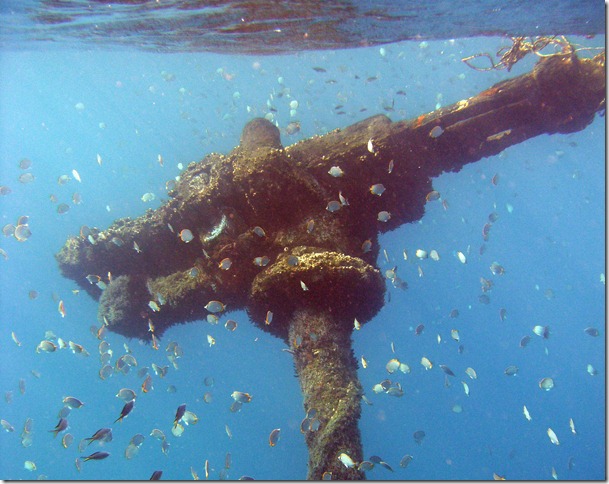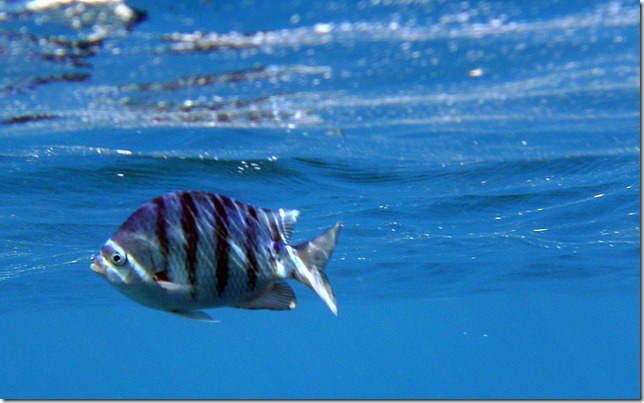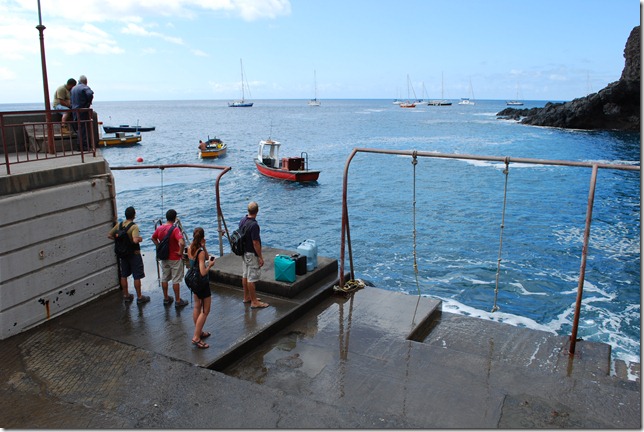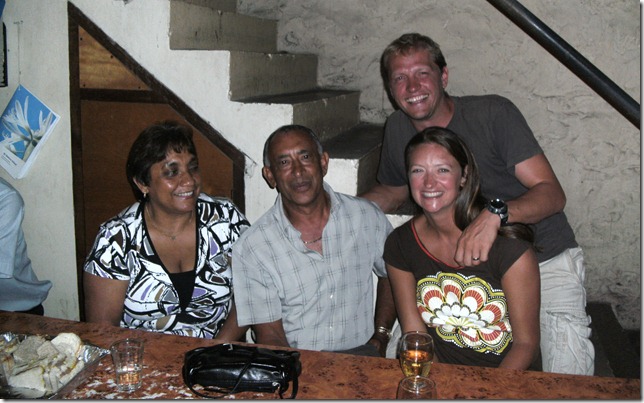Lat: 15 23.910′ S
Lon: 8 16.420′ W
We set Saturday at noon as our departure time, so Saturday morning we started our last round of chores — changing the zinc on the port prop shaft, doing a bit of bottom cleaning, lugging the last load of water jugs, and doing our final provisioning. But, with only an hour or two to go, we heard a familiar sound on the radio: S/V Marionette was calling us to let us know that they were only an hour or so away from the anchorage.
We met them ashore and by time our late lunch was over, they’d talked us into staying the night. We counted about 10 times that we’ve run into them since first meeting in Panama, but this will be the last time. They’re headed north to the Cape Verde islands and back to Europe while we head west to Recife, Brazil. It’s fun to see them not just because we’ve become friends, but because they travel without an autopilot, shortwave radio, or sat phone, so we never know exactly where they are or when or where we’re going to see them.
With the extra time, we decided to spend the afternoon snorkeling one of the wrecks in the James Bay. Its caught fire with about 350 people aboard and sank without any loss of life. A portion of the stern is still above water most of the time, so it wasn’t too hard to find. The visibility here isn’t what it is in some places, but at 50′ or so, it’s still enough to enjoy the wreck and all the fish. There were plenty of tropical species and some incredibly large schools (hundreds and hundreds) of juvenile butterfly fish. We even saw a school of medium-sized bonito swim by, which was something we’ve never seen before. They look like a generic silver tuna-type fish, only a little narrower and with a black and white rectangular Polynesian-style tattoo on their flank. The wreck itself was pretty massive. After a couple of minutes, I gave up on trying to reach the bow and just turned back to enjoy the fish that seemed to prefer the stern.
 The stern of the wreck stuck above water at low tide
The stern of the wreck stuck above water at low tide
 There were schools of hundreds of juvenile butterfly fish, the most we’ve ever seen
There were schools of hundreds of juvenile butterfly fish, the most we’ve ever seen
 Not sure what this guy is, but he was photogenic
Not sure what this guy is, but he was photogenic
We were the only boat that had our dinghy in the water during the time we were there. The moon is nearly full, and the spring tides were causing the swell to sweep over the concrete wharf at a foot or two deep. Jumping off of the small, sturdy wooden ferry boat onto the concrete wharf as the swell is heaving and crashing on the nearby rocky shore is all about timing. I asked how bad it gets, and the ferry driver pointed to a steel railing atop the highest point on the sea wall. It’s about 15 or 20 feet above sea level, even at high tide. He said last year he put the keel of the ferry boat on that rail more than once in large swells. Under those conditions, he said he sometimes limits ferry passengers to the local fishermen, but he still runs the ferry every day. Apparently there haven’t been any serious injuries, but he does have to fish the occasional intoxicated would-be passenger out of the drink after an ill-timed leap.
 The swell was sometimes nearly to our knees while waiting for the ferry. Note the Tarzan ropes to help with getting on/off and the rail at the top left where the ferry (yellow boat left of center) has set its keel in a bad swell.
The swell was sometimes nearly to our knees while waiting for the ferry. Note the Tarzan ropes to help with getting on/off and the rail at the top left where the ferry (yellow boat left of center) has set its keel in a bad swell.
With no airport, St. Helena relies on a vessel called the RMS St. Helena for resupply and transit to South Africa. It’s normal route is Cape Town, St. Helena, Ascension and return, stopping in St. Helena every two weeks or so depending on weather and occasional changes in the route. There is a good-sized hospital with several doctors and a surgeon to care for the population of 3500, but if something too serious happens, our 75-year-old tour guide Robert advised that “well then, maybe you just pack it in and call it quits, see.” Apparently an airport has been in the works for 37 years. It’s still a topic of conversation, with some hoping for increased tourism and tax revenue and others concerned that it will change the island’s atmosphere forever. The “tele” only arrived here about 15 years ago and already the older generation say it’s eroded the social scene. Another unique thing about St. Helena is that it has no cell phone service. The island is served by landlines and 4-digit phone numbers. Considering how ubiquitous the cell phone has become it was a real surprise. We’ve been to places with huts and no electricity where you have to go into town or the next village to charge your phone, but there is still service. It think it’s the only place we’ve been where there is municipal electricity but no cell phone service (the other way around being not at all uncommon).
In one of the pubs, we met some “natives”, who often work on Ascension and the Falklands for years at a time in military bases. The natives are good-looking people with dark hair and skin. They’ve come from a variety of ethnic backgrounds since the island was discovered about 500 years ago, but seem to prefer being labeled as English. English is their first language, although through the generations it’s been passed down with such a strong and unique accent, that I asked several people before I was convinced that it is indeed the first and only language spoken here. They people of St. Helena are also incredibly friendly. You can strike up a nice conversation with pretty much anyone at any time, and I’ve never been the recipient of so much generosity in the pub. We went out with half the money we thought we would need and came back with half of it left.
 St. Helena has some of the friendliest locals we’ve met, and it pays to drink with the pub owner…
St. Helena has some of the friendliest locals we’ve met, and it pays to drink with the pub owner…
We timed our last jump off the of the ferry onto the boat at about 1 AM, and found a beautiful, fairly clear night, with a soft breeze out of the southeast. We decided to make an early start and by 1:30 AM we’d sailed off our anchor and away to the west without putting the engines in gear. I wasn’t worth much until about noon the next day, but the girls did a fine job of dealing with the sails, motoring through a calm, and raising the spinnaker. The spinnaker has been down once in fresher winds and is now back up. Skies have alternated between fully overcast and mostly clear. So far it seems like we’ve picked up where we left off before arriving at St. Helena, but with a little more wind and a bigger swell behind us.

